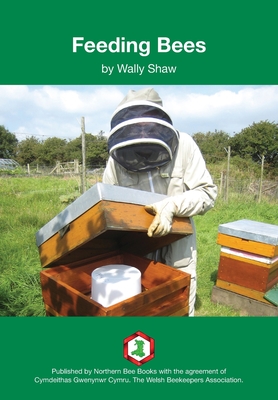
Feeding Bees
Paperback
ISBN13: 9781912271818
Publisher: Northern Bee Books
Published: Jan 11 2021
Pages: 32
Weight: 0.19
Height: 0.09 Width: 6.69 Depth: 9.61
Language: English
Honey bees collect two types of food material; nectar and pollen. With the collection of nectar there is no evidence that there is any selection based on its nutrient value, other than as a source of energy (their dietary carbohydrate). Pollen is their source of protein and lipids (fats). By contrast, foraging for this vital material is much more complex and seems to be based on the nutritional value of the pollen. Bees will forage for easily collected pollens but will also go out of their way to obtain supplies of a diverse range of other pollens that may require much more effort. How much and how often a beekeeper needs to feed honey bee colonies depends on beekeeping practices, e.g. how much of their honey is harvested. But the environmental conditions to which they are exposed (primarily forage availability and climate) also needs to be taken into account. This booklet offers advice on what materials can safely be used to feed bees, at what times of year feeding may be required and how to assess their needs. Also discussed is the means of delivery; the types feeder that can be used and their pros and cons.
Also in
Agriculture
Sea of Grass: The Conquest, Ruin, and Redemption of Nature on the American Prairie
Marcotty, Josephine
Hage, Dave
Hardcover
We Are Eating the Earth: The Race to Fix Our Food System and Save Our Climate
Grunwald, Michael
Hardcover
The Mushroom at the End of the World: On the Possibility of Life in Capitalist Ruins
Tsing, Anna Lowenhaupt
Paperback
The Home Blacksmith: Tools, Techniques, and 40 Practical Projects for the Home Blacksmith
Ridgway, Ryan
Paperback
An Absolute Beginner's Guide to Keeping a Pet Rabbit: Handling, Feeding, Housing, and Grooming
Cinteza, Adriana
Paperback
The Last Sweet Bite: Stories and Recipes of Culinary Heritage Lost and Found
Shaikh, Michael
Hardcover
Let's Become Fungal!: Mycelium Teachings and the Arts: Based on Conversations with Indigenous Wisdom Keepers, Artists, Curators, Feminists and Mycolog
Ostendorf-Rodríguez, Yasmine
Paperback
Chicken Keeping Pure and Simple: A Fun, Friendly Guide to Backyard Chicken Keeping
Husted, Nikki
Paperback
The Science of Spice: Understand Flavor Connections and Revolutionize Your Cooking
Farrimond, Stuart
Hardcover
Basic Butchering of Livestock & Game: Beef, Veal, Pork, Lamb, Poultry, Rabbit, Venison
Mettler, John J.
Paperback
The Beekeeper's Bible: Bees, Honey, Recipes & Other Home Uses
Jones, Richard a.
Sweeney-Lynch, Sharon
Hardcover
Accidental Shepherd: How a California Girl Rescued an Ancient Mountain Farm in Norway
Greensfelder, Liese
Hardcover
Animal, Vegetable, Miracle - Tenth Anniversary Edition: A Year of Food Life
Kingsolver, Camille
Hopp, Steven L.
Kingsolver, Barbara
Paperback
Farming While Black: Soul Fire Farm's Practical Guide to Liberation on the Land
Penniman, Leah
Paperback
Beekeeping For Beginners: The Beginning Beekeepers Guide on Keeping Bees, Maintaining Hives and Harvesting Honey
Morrow, Erin
Paperback
The Self-Sufficient Life and How to Live It: The Complete Back-To-Basics Guide
Seymour, John
Hardcover
The Living Soil Handbook: The No-Till Grower's Guide to Ecological Market Gardening
Frost, Jesse
Paperback
We Can Do Better: Collected Writings on Land, Conservation, and Public Policy by Paul Johnson
Johnson, Paul
Paperback
Home-Grown Mushrooms from Scratch: A Practical Guide to Cultivating Mushrooms Outside and Indoors
Wurth, Magdalena
Wurth, Herbert
Paperback
Green Gold: The Avocado's Remarkable Journey from Humble Superfood to Toast of a Nation
Allaback, Sarah
Parsons, Monique F.
Hardcover
Snoopy and the Spy: A Saga of Espionage, Ingenuity, and the Epic Battle to Save International Harvester
Klancher, Lee
Hardcover
Tractor Wars: John Deere, Henry Ford, International Harvester, and the Birth of Modern Agriculture
Dahlstrom, Neil
Hardcover
The Fleece & Fiber Sourcebook: More Than 200 Fibers, from Animal to Spun Yarn
Robson, Deborah
Ekarius, Carol
Hardcover
How to Speak Chicken: Why Your Chickens Do What They Do & Say What They Say
Caughey, Melissa
Paperback
An Illustrated Catalog of American Mushrooms
Us Department of Agriculture Maurice B Walters Collection
Hardcover
Food for Life: The New Science of Eating Well, by the #1 Bestselling Author of Spoon-Fed
Spector, Tim
Paperback
The Market Gardener: A Successful Grower's Handbook for Small-Scale Organic Farming
Fortier, Jean-Martin
Paperback
Mushrooming Without Fear: The Beginner's Guide to Collecting Safe and Delicious Mushrooms
Schwab, Alexander
Paperback
The Oyster Book: A Chronicle of the World's Most Fascinating Shellfish--Past, Present, and Future
Martino, Dan
Hardcover
White Light: The Elemental Role of Phosphorus-In Our Cells, in Our Food, and in Our World
Lohmann, Jack
Hardcover
Keeping a Family Cow: The Complete Guide for Home-Scale, Holistic Dairy Producers, 3rd Edition
Grohman, Joann S.
Paperback
Dark Calories: How Vegetable Oils Destroy Our Health and How We Can Get It Back
Shanahan, Catherine
Hardcover
Land Rich, Cash Poor: My Family's Hope and the Untold History of the Disappearing American Farmer
Reisinger, Brian
Paperback
Debunked by Nature: How a Vegan-Chef-Turned-Regenerative-Farmer Discovered that Mother Nature Is a Conservative
Engelhart, Mollie
Paperback
The Complete Guide to Home Permaculture: How to Transform Your Yard Into a Thriving and Productive Ecosystem
Hall, Brandy
Hardcover
Wicked Bugs: The Louse That Conquered Napoleon's Army & Other Diabolical Insects
Stewart, Amy
Hardcover
Feed the People!: Why Industrial Food Is Good and How to Make It Even Better
Dutkiewicz, Jan
Rosenberg, Gabriel N.
Hardcover
The Backyard Chicken Keeper's Bible: Discover Chicken Breeds, Behavior, Coops, Eggs, and More
Ellis, Sonya Patel
Ford, Jessica
Federman, Rachel
Hardcover
Beeswax Alchemy: How to Make Your Own Soap, Candles, Balms, Creams, and Salves from the Hive
Ahnert, Petra
Paperback
An Illustrated Catalog of American Fruits & Nuts
Us Department of Agriculture Pomological Watercolor Collecti
Hardcover
Epic Homesteading: Your Guide to Self-Sufficiency on a Modern, High-Tech, Backyard Homestead
Espiritu, Kevin
Paperback
The Julia Rothman Collection: Farm Anatomy, Nature Anatomy, and Food Anatomy
Rothman, Julia
Paperback
Healing Grounds: Climate, Justice, and the Deep Roots of Regenerative Farming
Carlisle, Liz
Hardcover
Polyface Designs: A Comprehensive Construction Guide for Scalable Farming Infrastructure
Slattery, Chris
Salatin, Joel
Paperback
The Field Guide to Fleece: 100 Sheep Breeds & How to Use Their Fibers
Ekarius, Carol
Robson, Deborah
Paperback
Unraveling: What I Learned about Life While Shearing Sheep, Dyeing Wool, and Making the World's Ugliest Sweater
Orenstein, Peggy
Paperback
You Can Farm: The Entrepreneur's Guide to Start and Succeed in a Farm Enterprise
Salatin, Joel
Paperback
One-Cow Revolution: Achieving Food Independence with a Grass-Fed Family Cow
Dougherty, Shawn
Dougherty, Beth
Paperback
The Painful Truth about Hunger in America: Why We Must Unlearn Everything We Think We Know--And Start Again
Chilton, Mariana
Hardcover
Animals Make Us Human: Creating the Best Life for Animals
Grandin, Temple
Johnson, Catherine
Paperback
Farming the Woods: An Integrated Permaculture Approach to Growing Food and Medicinals in Temperate Forests
Mudge, Ken
Gabriel, Steve
Paperback
The Backyard Homestead Seasonal Planner: What to Do & When to Do It in the Garden, Orchard, Barn, Pasture & Equipment Shed
Hansen, Ann Larkin
Paperback
The Lost Flock: Rare Wool, Wild Isles and One Woman's Journey to Save Scotland's Original Sheep
Cooper, Jane
Paperback
Farmall Cub Encyclopedia: The Essential Guide to Models, History, Implements, and Repair
Gingell, Rachel
Updike, Kenneth
Paperback
The Regenerative Garden: 80 Practical Projects for Creating a Self-Sustaining Garden Ecosystem
Rose, Stephanie
Paperback
The Chicken Health Handbook: A Complete Guide to Maximizing Flock Health and Dealing with Disease
Damerow, Gail
Paperback
A Forest of Your Own: The Pacific Northwest Handbook of Ecological Forestry
Hanson, Kirk
Zuckerman, Seth
Paperback
The First-Time Homesteader: A Complete Beginner's Guide to Starting and Loving Your New Homestead
Sowards, Jessica
Paperback
Storey's Guide to Raising Sheep, 5th Edition: Breeding, Care, Facilities
Ekarius, Carol
Simmons, Paula
Paperback
A Bite-Sized History of France: Gastronomic Tales of Revolution, War, and Enlightenment
Mitchell, Jeni
Hénaut, Stéphane
Paperback
On Gold Hill: A Personal History of Wheat, Farming, and Family, from Punjab to California
Moyer, Jaclyn
Paperback
Life and Death of the American Worker: The Immigrants Taking on America's Largest Meatpacking Company
Driver, Alice
Paperback
The Swine Republic: Struggles with the Truth about Agriculture and Water Quality
Jones, Chris
Paperback
What Your Food Ate: How to Restore Our Land and Reclaim Our Health
Montgomery, David R.
Biklé, Anne
Paperback
The Independent Farmstead: Growing Soil, Biodiversity, and Nutrient-Dense Food with Grassfed Animals and Intensive Pasture Management
Dougherty, Shawn
Dougherty, Beth
Paperback
Land Rich, Cash Poor: My Family's Hope and the Untold History of the Disappearing American Farmer
Reisinger, Brian
Hardcover
Taste the Limestone, Smell the Slate: A Geologist Wanders Through the World of Wine
Maltman, Alex
Hardcover
Lumberjack: Inside an Era in the Upper Peninsula of Michigan - 70th Anniversary Edition
Crowe, William S.
Paperback
Song of Increase: Listening to the Wisdom of Honeybees for Kinder Beekeeping and a Better World
Freeman, Jacqueline
Paperback
Backyard Beekeeping: Everything You Need to Know to Start Your First Hive
Burns, David
Burns, Sheri
Paperback


 Sign-In
Sign-In Cart
Cart